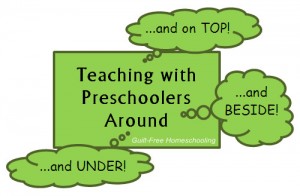Believe it or not, there are (so-called “successful”) students in the government system who do not know that a dictionary contains word meanings, word forms, and pronunciation guides. These students have no clue what an atlas is or how/why to use one; they are clueless at map reading. They would never guess that the lesson concepts are fully explained in the textbook — they assume that only the teachers’ books have the explanations in them. If someone does not tell them what to do, they cannot decide what to do on their own, and even then, they only do exactly what they have been told, and no more. They possess no “critical thinking skills.”
When a student can teach himself, there are no limits to what he can learn. When a student can teach himself, learning becomes a life-long endeavor. When a student can teach himself, you (as the teacher) are then freed up to attend more to younger students, household duties, or even (dare I say it?) spare time activities of your own choosing.
The biggest hurdles for any student learning to teach himself are:
1) How do I know what to do in this lesson? (reading & understanding directions)
2) Where should I look for more information? (research skills)
3) What should I do when I “get stuck”? (problem-solving skills)
So how, you are now asking, do you teach a student to teach himself? Refer to The Biblical Model of Discipleship: “Let them watch, let them help, help them do it, watch them do it, leave them doing it.” As you are teaching him to read, also point out each word of the directions on any workbook pages or math papers that he is doing as you read those directions aloud and then explain what the assigned task is. That will begin to make the connection for him that those words mean important things, too. We need to convey the concept that the words in storybooks are not the only words in life that count. The same thing can be done with the Sunday comics, captions for interesting photos in newspapers and magazines, and even the cooking instructions on convenience food packages. Gradually, the idea will be grasped that with reading ability comes the knack for finding the necessary words to read. (Newspapers, magazines, and the adult world in general can be overwhelming to a new reader: so many words and no clue for how to navigate through them.)
As the student gains reading ability, he will begin to be able to read those directions for himself. If he is still not able to make the transition from reading the directions to understanding the assignment, have him read the directions aloud to you. Then discuss the meaning of the sentences with him until the student understands how they are explaining what is expected of him.
Begin to slow down your response time in explaining the assignments, allowing the student plenty of time to think about what he is reading and process the information. Remember that this is a new task for your student, and like any new task, it takes time to learn.
With more complicated instructions, such as those found in upper lever math lessons, point out to the student that everything needed to understand the lesson is found in the book. The complete explanation is in the lesson (some details may have been covered in previous lessons). The most important concepts will be in bold print, italics, underlined, or set apart in a box to capture the student’s attention. Example problems should not be merely looked at (unless the student is especially gifted in math), but copied step-by-step into the student’s math notebook (noted with page and problem numbers), in an effort to understand what is being done and why. (We remember more of what we do, than of what we just see or hear.) All math problems should be written in a notebook and kept, so they can be referred back to when necessary for additional help — problems written on a chalkboard or whiteboard are lost forever once they have been erased. When a student encounters a math problem of a type that gave him difficulty before, he can then look back through his notebook to find the previous example. Studying its completed form will help the student see what step comes next for the current problem.
I have sometimes questioned my own performance as a homeschool educator — did I do a “good enough” job? I see things that my children “missed” and wonder why I did not press those lessons more. Then again, I realize that I learned as much as they did during our homeschool career, and they will learn more as they begin to homeschool their own children in a few years. My students did learn how to read and how to understand what they read. My students learned how to do research. My students learned how to solve problems, often coming up with unique ideas that I would not even have considered. My students have become young adults who will continue to learn for their entire lives, because they learned how to teach themselves.





 Guilt-Free Homeschooling is the creation of Carolyn Morrison and her daughter, Jennifer Leonhard. After serious disappointments with public school, Carolyn spent the next 11 years homeschooling her two children, from elementary to high school graduation and college admission. Refusing to force new homeschooling families to re-invent the wheel, Carolyn and Jennifer now share their encouragement, support, tips, and tricks, filling their blog with "all the answers we were looking for as a new-to-homeschooling family" and making this website a valuable resource for parents, not just a daily journal. Guilt-Free Homeschooling -- Equipping Parents for Homeschooling Success!
Guilt-Free Homeschooling is the creation of Carolyn Morrison and her daughter, Jennifer Leonhard. After serious disappointments with public school, Carolyn spent the next 11 years homeschooling her two children, from elementary to high school graduation and college admission. Refusing to force new homeschooling families to re-invent the wheel, Carolyn and Jennifer now share their encouragement, support, tips, and tricks, filling their blog with "all the answers we were looking for as a new-to-homeschooling family" and making this website a valuable resource for parents, not just a daily journal. Guilt-Free Homeschooling -- Equipping Parents for Homeschooling Success!

Recent Comments